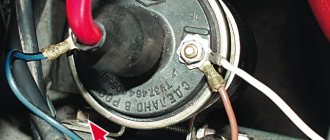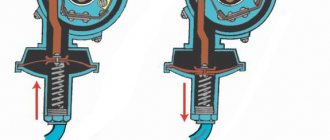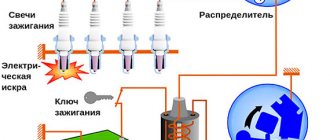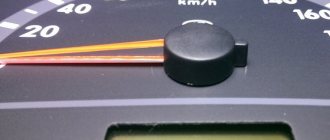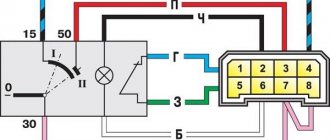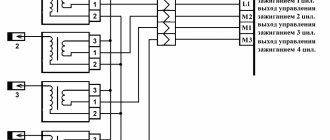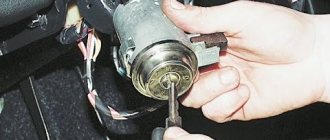The ignition coil is the main element of the ignition system of any vehicle equipped with an internal combustion engine. The second name is transformer, but no matter what this part is called, it is necessary for the timely start of the engine.
After all, it is the coil that is responsible for igniting the fuel-air mixture; it transmits voltage to the spark plugs. What this part is, what its structural features and types are, will be discussed in our material today.
What is an ignition coil and why is it needed?
As mentioned above, the main task of the coil is to supply high voltage to the spark plug, after which a spark appears, which, in turn, ignites the fuel-air mixture. If there are interruptions in the operation of the coil, the ignition system begins to function incorrectly, as a result, the engine power decreases, and there are frequent cases when the car stops starting altogether.
Important
The part that has become the subject of our interest is used in all ignition systems without exception - contactless, contact, electronic.
From a design point of view, it is a transformer with two windings. As of today, you can buy an ignition coil of one of three types - common, dual or individual, we will talk about them in more detail later.
Conclusion
One of the important components in a car is the bobbin, which creates high voltage to produce a spark. If dips appear in the engine’s operation, it begins to stall and simply run unstably – this could be the cause. Therefore, it is important to know how to check the ignition coil correctly, and if necessary, using the old-fashioned method, in the field.
Sources
- https://VazNeTaz.ru/katushka-zazhiganiya
- https://www.avtoall.ru/article/4555827/
- https://AvtoMotoProf.ru/obsluzhivanie-i-uhod-za-avtomobilem/chto-iz-sebya-predstavlyaet-katushka-zazhiganiya-avtomobilya/
- https://SwapMotor.ru/ustrojstvo-dvigatelya/katushka-zazhiganiya.html
- https://avtozam.com/elektronika/pusk/printsip-raboty-katushki-zazhiganiya/
- https://TechAutoPort.ru/dvigatel/sistema-zazhiganiya/katushka-zazhiganiya.html
- https://ZnanieAvto.ru/fire/katushka-zazhiganiya-sxema-ustrojstvo-i-podklyuchenie.html
Ignition coil device
As mentioned above, an ignition coil is a small transformer with a primary and secondary winding. The core is located inside these windings, and the insulated casing is located outside. The primary winding includes a copper wire with insulation, twisted into turns, the number of which can vary from 100 to 150. The terminals of the winding are 12 volts.
As for the secondary winding, it is located above the primary and consists of even more turns of thin copper wire. The number of such turns ranges from 15-30 thousand.
It is here that high voltage is created, capable of reaching 35 thousand volts and transmitted to the spark plugs. When it comes to oil-type coils, they have transformer oil inside, which prevents the part from heating.
Questions on the topic
Filter:AllOpenSolvedClosedWaiting for response
What is the price of an ignition coil for Mazda 6? Answered by User Answered 8 months ago • Ignition system
21 views 1 answer. 0 vote.
Car troubles, problem with Infiniti FX coils Answered by User answered 8 months ago • Ignition system
21 views 1 answer. 0 vote.
Which coil can replace the Ford Fiesta Mk1 1.1 ignition coil? Answered by User Answered 8 months ago • Ignition system
28 views 1 answer. 0 vote.
How to check the ignition coil of a Hyundai Santa Fe Classic? Answered by User Answered 8 months ago • Ignition system
41 views 1 answer. 0 vote.
Are the ignition coils burning out on your Toyota Corolla? Answered by User Answered 8 months ago • Ignition system
30 views 1 answer. 0 vote.
Ask a Question
Principle of operation
The functionality of this element of the ignition system is ensured as follows. Low voltage voltage is supplied to the primary winding, it contributes to the appearance of a magnetic field. Periodically, this voltage is cut off, which leads to a sharp reduction in the magnetic field and the appearance of the so-called emf on the turns. (electromotive force).
In accordance with the laws of physics, the electromotive force is directly proportional to the number of turns of the circuit. In the secondary winding, the number of turns on which is significantly greater, high voltage pulses occur and are transmitted to the spark plug. Most often, transmission occurs through high-voltage wires.
The impulse leads to the formation of a spark between the electrodes of the spark plug, which ignites the fuel-air mixture. Older cars had another component called the ignition distributor.
It served to uniformly supply voltage to all spark plugs. However, over time, automakers abandoned this solution, considering it unreliable. That is why in modern vehicles there is an ignition coil on each of the spark plugs.
Life time
The part does not have a clearly defined service life. In theory, it can work for an unlimited amount of time. In practice, after a few years it fails. This is due to the fact that during the conversion of low-voltage current to high-voltage current, the winding heats up. This can cause one of two consequences:
- insulation burnout, which leads to a decrease in winding resistance;
- burnout of the winding itself, which results in complete breakdown of the part.
Types of ignition coils
The ignition coils available on the market and used in the design of modern cars are common and individual.
Common coils are used in systems both equipped with a distributor and without it. In terms of design, such models differ in the following features: the primary winding is located outside, the secondary winding is inside, in the center of which the core is located. All this is housed in a steel body. The spark plugs are supplied with a pulse generated on the secondary winding.
As for individual coils, they are installed in systems in which electronic ignition is direct. The design of such components differs significantly from that described above, because the secondary winding here is located on top of the primary. Individual coils are mounted directly on the spark plug, hence the name. The impulse is transmitted in full, no power is lost.
There are also dual coils, which are called two-terminal. Unlike classic models, there are two leads from the high-voltage winding, which makes it possible to spark sparks on two spark plugs at once. In this case, in one of the cylinders the fuel mixture ignites at the end of the stroke, and in the second - at the moment of exhaust. Similar solutions are used in engines with an even number of cylinders. The ignition system in this case is simpler; there is no distributor.
In classic coil models, there is transformer oil inside, which, as mentioned above, prevents overheating of the winding. Metal is used to produce the case, and such a solution can hardly be called rational, so an alternative option has become more widespread - the so-called. "dry" transformers.
They do not have a housing, but have an epoxy coating that performs a dual function - cooling the part and protecting it from dirt and damage. In some cases, combined solutions are used, when a dry coil is combined with a contact switch or it is built into a distributor.
Photo gallery
Photos of different types of devices are presented in this section.
Classic machine short circuit
Individual short circuits for each candle
Dual type device
How to check the ignition coil
Checking the ignition coil can be done in several ways, but most often motorists resort to checking for a spark. The advantage of this method is its accessibility, the disadvantage is the inaccuracy of the result. To perform diagnostics, you should take a spark plug wrench, pliers and a spark plug that is absolutely in good working order.
The check is performed as follows:
- The integrity of the wiring from the spark plugs to the coil itself is visually assessed. The inspection is carried out with the ignition off.
- If the wires are in order, you need to remove the tip from the spark plug on the first cylinder and connect it to a spark plug that you are sure is working.
- Turn on the ignition, that is, start the engine.
- Pay attention to the color of the spark - if it is barely noticeable and yellowish in color, there is a problem with the wiring or the coil. If there is no spark, the object of our interest is faulty, which means that the ignition coil will have to be replaced.
- If the car is equipped with individual coils, the steps described above should be performed on each spark plug. You need to act carefully and avoid touching live wires.
To obtain the most accurate result, the transformer is checked using a special device - a multimeter. Normal ignition coil resistance ranges from 0.2 to 3 ohms depending on the model.
Common malfunctions, their symptoms and solutions
The following signs indicate that the ignition system transformer is functioning intermittently:
- The engine "troubles" and becomes stronger over time.
- At sub-zero temperatures, “triple movement” is observed only until the engine warms up.
- When it’s damp “overboard,” the engine runs intermittently.
If at least one of the listed signs is noticed, you need to diagnose the coil yourself or seek help from a service station.
The causes of transformer breakdowns include mechanical damage caused by ordinary wear and tear, oil leakage that gets on the insulation and destroys it. In this case, it is better to replace the part, since repairing the ignition will be an almost impossible task.
Individual coils are subject to overheating, which significantly reduces their service life. To prevent it, experts recommend using coolant of proper quality and monitoring the health of the cooling system.
